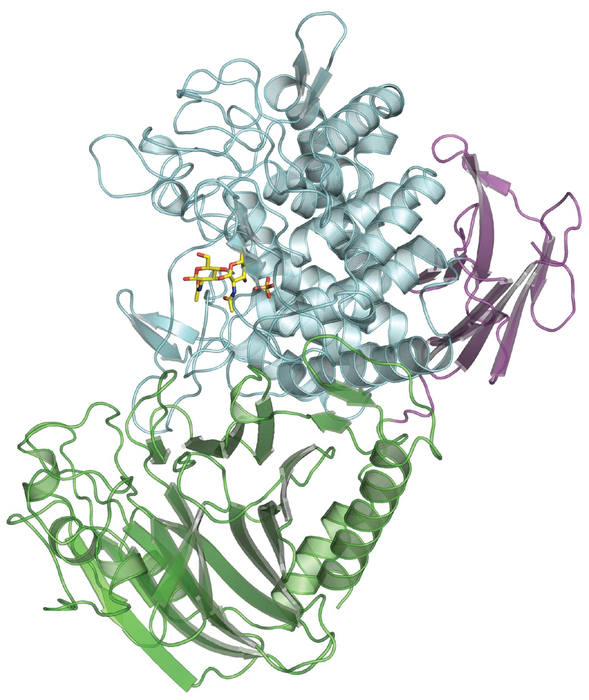Strings of sugars called polysaccharides are the most abundant biopolymers on Earth. Because of their versatile and environmentally friendly properties, these molecules could eventually replace some plastics. Now, researchers reporting in ACS Central Science have identified a previously unknown bacterial enzyme that can make a new type of polysaccharide, which is similar to the biopolymer chitin. The new molecule is biodegradable and could be useful for drug delivery, tissue engineering and other biomedical applications.

Credit: Adapted from ACS Central Science 2022, DOI: 10.1021/acscentsci.1c01570
Strings of sugars called polysaccharides are the most abundant biopolymers on Earth. Because of their versatile and environmentally friendly properties, these molecules could eventually replace some plastics. Now, researchers reporting in ACS Central Science have identified a previously unknown bacterial enzyme that can make a new type of polysaccharide, which is similar to the biopolymer chitin. The new molecule is biodegradable and could be useful for drug delivery, tissue engineering and other biomedical applications.
Polysaccharides play many roles in organisms, and because they are biocompatible and biodegradable, these molecules are promising carrier materials for a broad range of therapeutics. The identity of individual sugar molecules in the chain, and the way they are linked together, make them function in different ways. Enzymes known as glycoside phosphorylases can cut certain polysaccharides apart or make new ones, depending on the reaction conditions. For example, one such enzyme makes chitin, the major component of arthropod exoskeletons and fungal cell walls. Stephen Withers and colleagues wondered if there might be previously unknown, naturally occurring enzymes that could make new types of polysaccharides.
Using genomic data and activity-based screening, the researchers identified a glycoside phosphorylase enzyme from bacteria called Acholeplasma laidlawii, a common contaminant of laboratory cell cultures. The team expressed and purified the enzyme, discovering that it could synthesize a new type of polysaccharide, which they named acholetin. The new biopolymer is similar in composition to chitin and to a biofilm-forming polysaccharide, but its sugar molecules are linked together in way that differs from these known biopolymers. The team determined the crystal structure of the glycoside phosphorylase, which they suspect could be involved in maintenance of A. laidlawii’s cellular membrane. As such, researchers might be able to target the enzyme to prevent cell culture contamination with the bacteria, in addition to using the enzyme to make the new biopolymer. Acholetin has wide-ranging potential as a new type of biocompatible, biodegradable material, the researchers say.
The authors acknowledge funding and support from the Natural Sciences and Engineering Research Council of Canada, the Canadian Institutes for Health Research, the U.S. Department of Energy, the Howard Hughes Medical Institute and the National Institutes of Health.
The paper’s abstract will be available on March 16 at 8 a.m. Eastern time here: http://pubs.acs.org/doi/abs/10.1021/acscentsci.1c01570
For more of the latest research news, register for our upcoming meeting, ACS Spring 2022. Journalists and public information officers are encouraged to apply for complimentary press registration by emailing us at [email protected].
The American Chemical Society (ACS) is a nonprofit organization chartered by the U.S. Congress. ACS’ mission is to advance the broader chemistry enterprise and its practitioners for the benefit of Earth and all its people. The Society is a global leader in promoting excellence in science education and providing access to chemistry-related information and research through its multiple research solutions, peer-reviewed journals, scientific conferences, eBooks and weekly news periodical Chemical & Engineering News. ACS journals are among the most cited, most trusted and most read within the scientific literature; however, ACS itself does not conduct chemical research. As a leader in scientific information solutions, its CAS division partners with global innovators to accelerate breakthroughs by curating, connecting and analyzing the world’s scientific knowledge. ACS’ main offices are in Washington, D.C., and Columbus, Ohio.
To automatically receive news releases from the American Chemical Society, contact [email protected].
Follow us: Twitter | Facebook | LinkedIn | Instagram
Journal
ACS Central Science
DOI
10.1021/acscentsci.1c01570
Article Title
A Synthetic Gene Library Yields a Previously Unknown Glycoside Phosphorylase That Degrades and Assembles Poly-β-1,3-GlcNAc, Completing the Suite of β‑Linked GlcNAc Polysaccharides
Article Publication Date
16-Mar-2022




